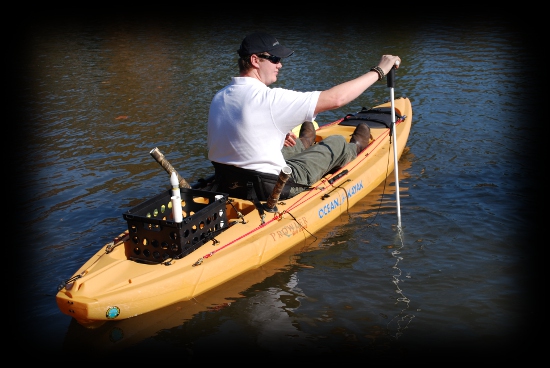“You plan on doing some spear fishing?” I can’t tell you how many times I have heard some variation of this line followed by a chuckle or two when I’m launching my fishing kayak in a public area in the Midlands of South Carolina. What onlookers are referring to is my stake out pole or anchor pin. While quite common in coastal areas, SOPs aren’t exactly popular around many of the lakes and rivers that I routinely fish. My SOP of choice (surprise, surprise) is the PKF 5’ solid fiberglass shaft option with T -handle and 550 paracord leash. Instead of having to toss out an anchor, the SOP allows me to quickly and quietly pin my kayak in shallow water. This is extremely useful in the wind or current. The SOP also removes the hassle of having to dodge the anchor line while fighting a hooked up fish.
SOPs can be used in a variety of ways. I deploy my SOP through one of the scupper holes in my sit-on-top kayak, slide it through the ring on my anchor trolley or use the supplied paracord leash to clip it to an eyelet on the deck.
The conditions usually dictate which method I chose. In choppy water, I use the 4’ leash because it allows me to put some distance between my kayak and the pole. This way I am not banging up against the SOP every time the wind blows or a wave rolls by. In rivers, I slide the SOP through one of the scuppers and wedge it into the river floor or between rocks. This method works exceedingly well in light current. If I am in a back cove, I slide the SOP through the ring in my anchor trolley. With a gently pull of the anchor trolley rope I can reposition the direction of my kayak with ease. No matter what method is used, having a leash allows the SOP to remain secured to the kayak at all times.
I’ve seen (and built) SOP’s constructed out of just about everything from PVC to wooden broom sticks, metal conduit to bamboo….the list goes on and on. After all, the basic “technology” isn’t exactly advanced – for all intensive purposes a SOP is essentially a pointed pole. But for those of us that take kayak fishing a little more seriously, fiberglass construction coupled with a few basic accessories can take the shallow water fishing experience to the next level.
Why fiberglass? It is durable* and is at home in a marine environment. Rigidity plays a very important role in SOP construction as well. There is a “sweet spot” between rigidity and flexibility for SOP construction. Like shocks on a car, a SOP that has some flex absorbs most of the impact from rough water, wind or current. Not only does the kayaker feel less jolt, the slight flex keeps the SOP firmly planted.
So whether you build your own SOP or purchase a commercially available one, this tool can greatly improve your kayak fishing experience in shallow water. If nothing else, it is a great conversation piece at the boat landing - especially if you tell the locals you are still after that white whale.
-Paul
* PKF’s Fiberglass Shaft SOPs are also coated in a special smooth outer sheath that won’t crack, yellow or otherwise deteriorate from water or UV exposure. For more information click here to visit PKF’s online store








No comments:
Post a Comment